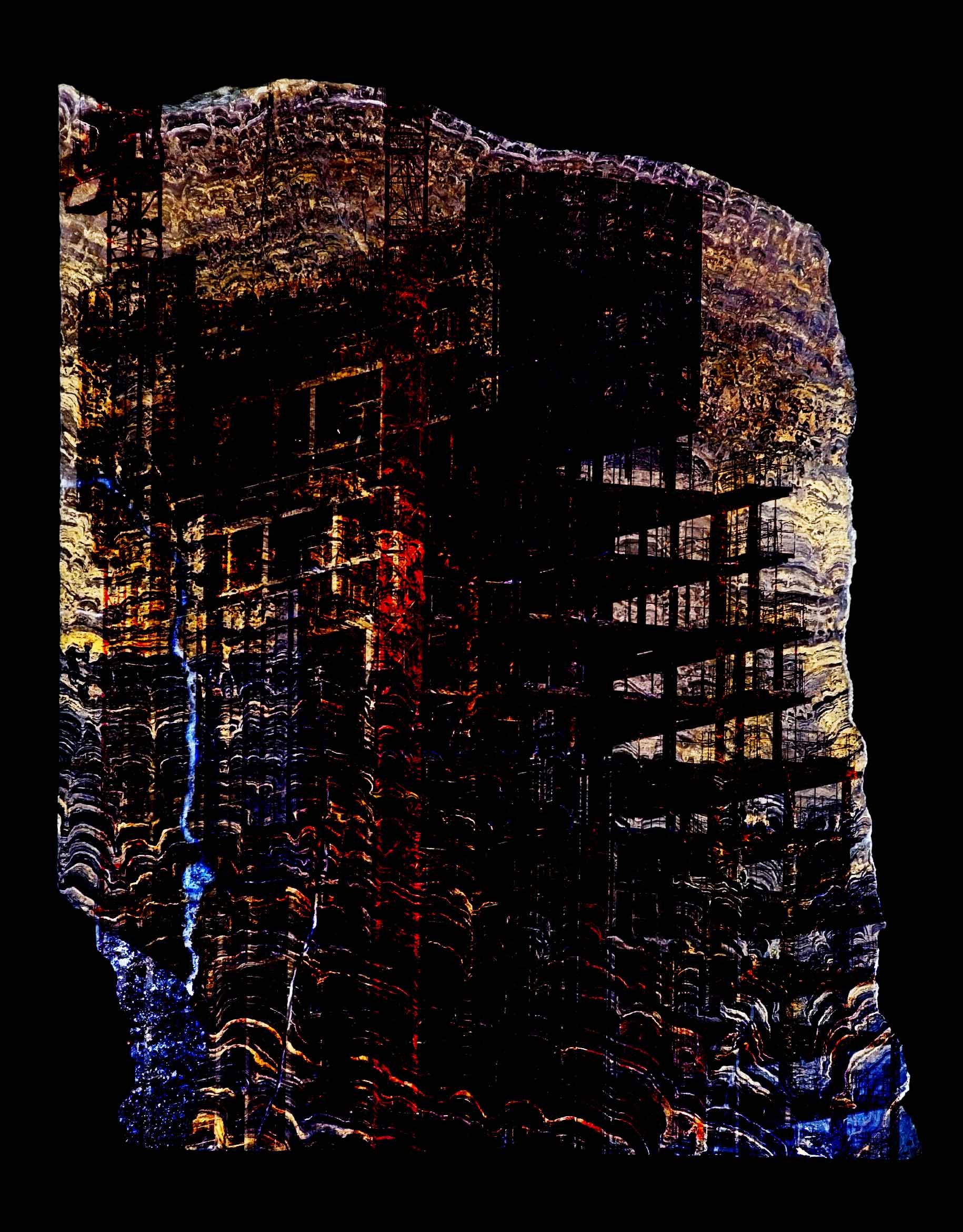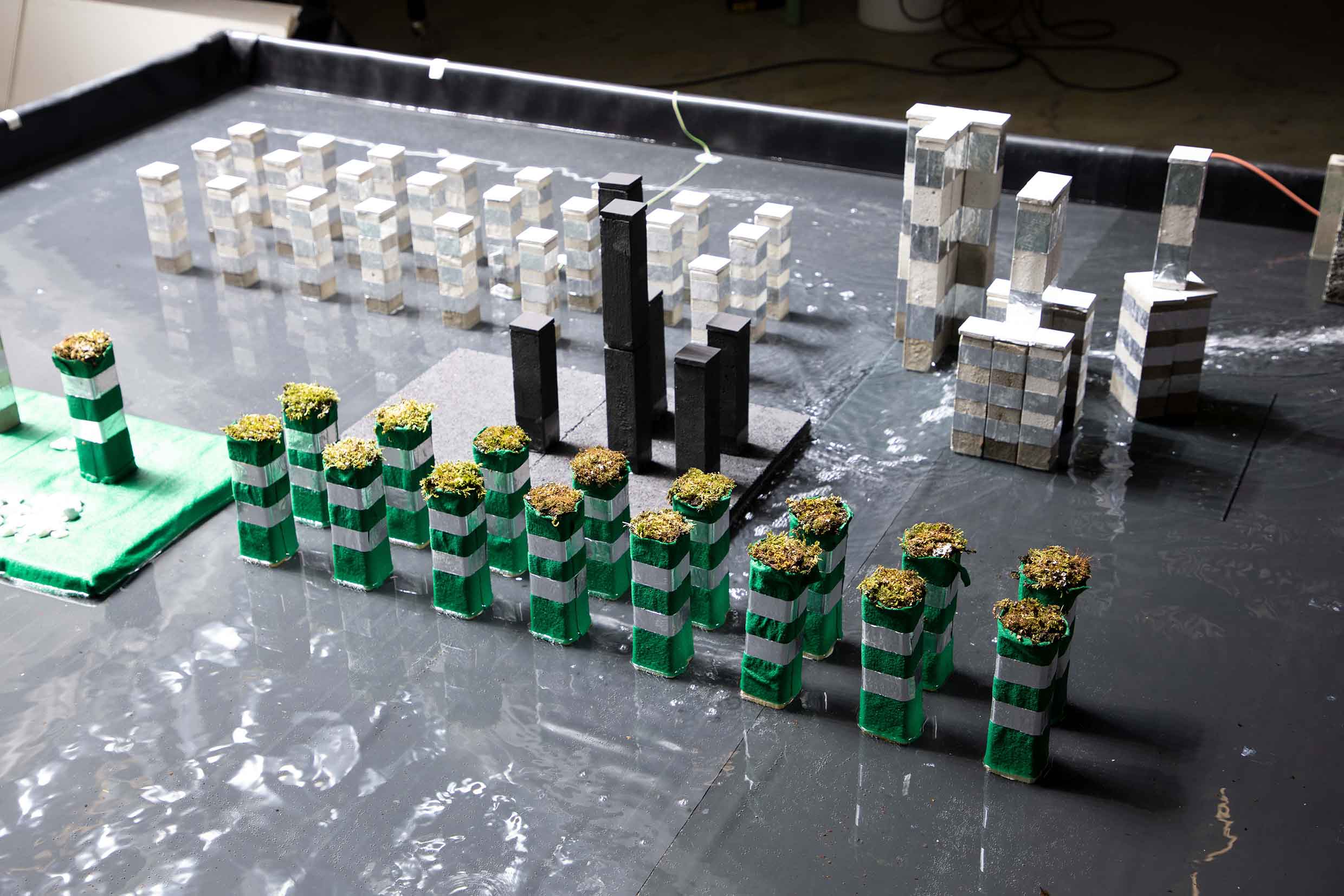Science meets art for the city of the future
The project “Primordial Cities” developed by the internationally renowned philosopher and conceptual artist Jonathon Keats is based on the first communities that lived on Earth - so-called stromatolite cities, inhabited by primitive microbes. Together with the Fraunhofer Institute for Building Physics IBP and based on research work by the scientists and their experience from urban climate projects, the experimental philosopher has developed an innovative urban scenario that takes a completely new approach and revolutionizes urban planning concepts by considering the changing climate. From 12 December onwards, the project is on show in an exhibition at the STATE Studio in Berlin.
By the year 2012, climate researchers now predict that the sea level could rise at least twice as fast as previously assumed. However, global warming will not only melt the polar ice caps and enlarge the oceans to the extent that entire regions and all their cities will be below sea level. The rising temperatures will also intensify urban heat islands, which will place an immense burden on people in large cities and megacities. In order to counteract these problems, over the last few months scientists at Fraunhofer IBP, led by the internationally renowned philosopher and conceptual artist Jonathan Keats, have been working on a completely new approach to new, ultra-resilient forms of architecture and urban infrastructure. This approach is based on the first communities of life forms that existed on our planet - stromatolites. Stromatolites are biogenic sedimentary rocks created from trapped and bound particles of sediment or precipitating dissolved substances as a result of the growth and metabolism of microorganisms in a body of water. What makes them special is that they grew in layers and combined organic matter with sediment. Step by step, the lower strata were “sacrificed” to become the basis for new layers of living matter. According to Keats, the principle of these so-called stromatolite cities could save highly-endangered metropolises such as Shanghai or Manhattan in the long term and also counteract one of the main causes of greenhouse gas emissions in the building and housing sector, namely the widespread use of energy-intensive air-conditioning systems.
The “Primordial Cities” initiative was started as part of the Fraunhofer “Artist in Lab” program at the Fraunhofer Institute for Building Physics IBP and accompanied by Prof. Gunnar Grün, Head of Energy Efficiency and Indoor Climate, and his colleagues. With its research work and expertise in the field of urban planning and climate change, Fraunhofer IBP was predestined to support Keats' philosophical approaches with real technological developments, such as by designing highly-adaptable buildings. Keats' designs were finally also influenced by the results obtained from the sunlight simulator at Fraunhofer IBP or by computer models generated by the Fraunhofer researchers.
With the aid of scientific methodology, the aim of the Primordial Cities Initiative is to present an architectural vision to the public, to think about it and discuss it together, to initiate political decisions and consequences and at the same time to promote a culture of courageous and imaginative planning.
In addition to this innovation project, Fraunhofer IBP is also represented in the pioneer project “Urban Climate in Transition” funded by the German Federal Ministry of Education and Research (BMBF) . Fraunhofer IBP also contributes its research expertise to the ATTRACT project “Urban Physical Modeling” and the BUOLUS project “Building Physical Design of Urban Surfaces for Sustainable Quality of Life and Environment in Cities”.
Efficient urban climate models - a research field for Fraunhofer IBP
Within the scope of the “Urban Climate Change” project funded by the German Federal Ministry of Education and Research (BMBF), from June 2016 to June 2019 Fraunhofer IBP scientists tested the application of the efficient urban climate model PALM-4U, including its validation and assessment of suitability for practical use. This model can be scaled from a single building to an entire neighborhood or even a large city such as Berlin. It also solves typical urban climatic issues such as wind or thermal comfort, including their impact on the climate inside buildings. The spread of pollutants can be simulated and the effects of people’s movements evaluated. In the sub-project UseUClim, the employees tested the first practical applications of the urban climate model and taught the participating practice partners - the environmental offices of the cities of Chemnitz, Dresden and Leipzig and the urban planners of Sweco GmbH - how to use the model prototypes in two training phases. Even at this early stage, the potential of integrating urban climate models into planning practice was clear to all involved.
The second phase has therefore been underway since October 2019. Among other things, the ProPolis consortium wants to extend the application possibilities of PALM-4U, provide an innovative and intuitive user interface and develop and assess training, support and service offers.
Within the scope of the planned UCARe4Citizen project funded by the German Federal Ministry of Economics and Energy (BMWi), a project team from Fraunhofer IBP is working on representing model results with Augmented Reality (AR) in conjunction with three-dimensional geodata and city models (GIS). An interactive communication platform will improve the dialog with municipalities, citizens and planners. Modern visualization techniques and intuitively operated terminals will enable planned measures and their effects on the physics of urban development to be experienced on a new level. Through the immersive experience of the urban climate model, effects such as strong winds, overheating and pollutants can be recorded immediately. By digitizing process chains, a new form of citizen participation in urban planning will be created.
Over the past decades, a large amount of theoretical knowledge has been acquired and empirical possibilities developed for predicting urban heat islands. The recently launched ATTRACT project “Urban Physical Modeling” headed by Dr. Afshin Afshari aims to put this knowledge into practice in order to make the management of cities more sustainable in the future. For this purpose, complete urban microclimates are also included in models. These are affected by numerous factors, such as buildings, road surfaces, water surfaces and vegetation, anthropogenic activities - but especially by traffic. The researchers are focusing on the development of models to estimate at least three different urban factors: outdoor thermal conditions, the energy consumption of buildings and air pollution. Another aim of the project is the early involvement and cooperation of all stakeholders such as architects, urban planners, engineers and contractors in order to design and plan sustainable cities more effectively. Based on a prior assessment of the impact of large-scale upgrading measures, new minimum energy efficiency requirements, district heating systems or changes in tariffs, the researchers also want to develop applications to aid energy policy decisions in cities.
In the BMBF research project BUOLUS (building physics design of urban surfaces for sustainable quality of urban living and environments) which is coordinated by Fraunhofer IBP, municipal and scientific institutions have joined forces with urban planners and developers, building companies and manufacturers of building materials to evaluate the potential impact of urban surfaces in residential areas, infrastructures, green spaces and buildings from the aspect of building physics. The aim is to tap this potential, to extend it by technological options and then to test measures in practice. New possibilities, methods, systems and materials will be investigated to make cities more resilient. The project is strongly geared to the actual requirements of municipalities, their current issues and pressing problems in this regard.
We cordially invite you to the opening of the exhibition on 12 December at STATE Studio (Hauptstraße 3, 10827 Berlin, Germany).
Opening program:
Opening on 12 December 2019, 6.30 pm
7 pm: Welcome speech Dorothee Höfter (Headquarters Communication Fraunhofer-Gesellschaft) and Dr Christian Rauch (STATE Studio)
7:15 pm - 8 pm: “Science meets Art” with Jonathon Keats (Artist-in-Lab), Prof Gunnar Grün (Residency Institute Fraunhofer IBP) and Dr Richard Hofmann (Museum für Naturkunde Berlin). The discussion is moderated by Dr Christian Rauch.
8 pm: Drinks, music and flying buffet
Opening hours: exhibition
12 December - 20 December & 7 January - 29 February,
Tues - Fri, 12 - 19, Sat 12 - 17.
Last modified:

